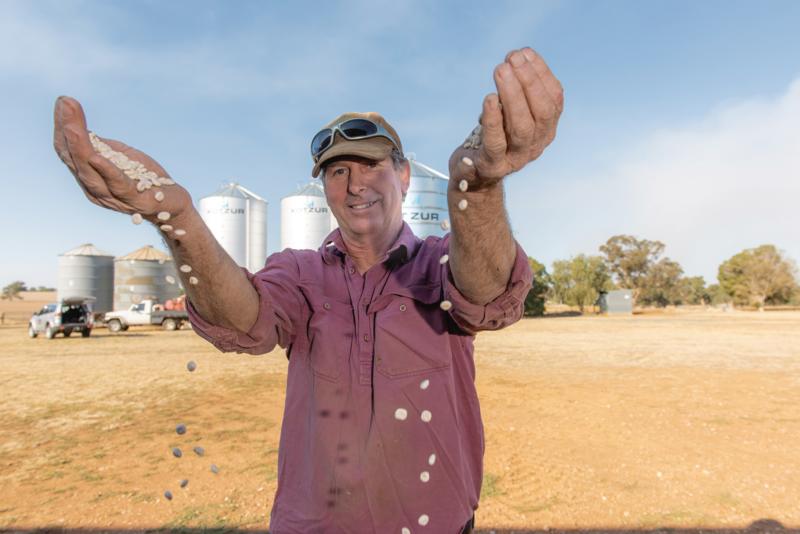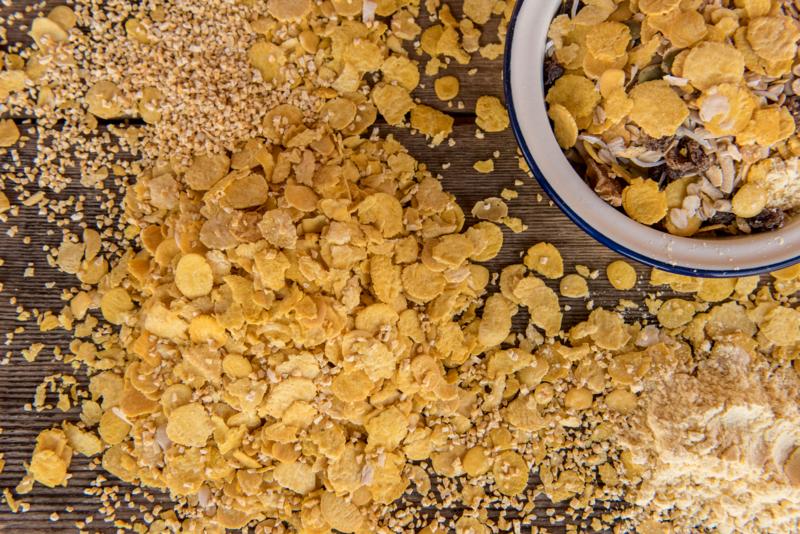This attitude has already paid off with a high-protein bread manufacturer using lupin flour, and their product even appearing on restaurant menus, such as at DiCasa in Melbourne’s Lygon Street. “For Gary to see his dream on the menu and on the plate… he was in tears,” Roger says. Gary acknowledges that he was overwhelmed, as was his wife Heather, who farms the land alongside him and experiments to come up with new lupin recipes. It’s already far bigger than anything Gary envisioned, and he’s long been regarded as a pioneer in everything from cropping to livestock.
Today, Lupins for Life is only wholesaling, but has an online shop due to launch by July. The Drews have held off going to market until they have security of supply and a good web presence. Lupin has been a time- and money-hungry project, as the brothers have even built their own mill and developed a milling process that de-hulls the lupin seed, leaving the kernel intact. And if Gary’s dreams are realised, it’s going to get even bigger.
 Gary with the lupin seeds at his mixed farming business. He also grows wheat and canola, and runs sheep.
Gary with the lupin seeds at his mixed farming business. He also grows wheat and canola, and runs sheep.
With a protein content of up to 40%, and containing 30% soluble fibre, lupin products have a high satiety value, so reduce the desire to overeat. Indeed, Gary has lost nearly 12kg simply by eating his lupin cereal for breakfast. “I haven’t even had to cut my beer consumption!” he says.
Lupin is low in fat, low GI, gluten-free, contains minimal starch and has been shown to lower blood pressure and cholesterol, and improve insulin sensitivity. Roger believes the legume could also prove valuable in Third World countries where famine and malnutrition are devastating populations.
The variety of lupin products, from flour to flakes, makes lupin easy to incorporate into dishes, sweet or savoury. The Drews are also interested in the possibility of using high-protein lupin flour in the production of meat substitutes, or “fake meat”. “That’s the biggest shift nutritionally at the moment,” Roger says. “It has to happen in the West because of social change, and it has to happen globally because of the need to feed more people.”
It seems the only negative to lupin is that it belongs to the peanut family and there is a small chance that people with a peanut allergy may also react to it. Food Standards Australia and New Zealand added lupin to its allergens list in 2017.
 The finished product, including lupin flour, flakes and kibble.
INNOVATION AND INGENUITY DRIVES SUCCESSFUL FARMING
The finished product, including lupin flour, flakes and kibble.
INNOVATION AND INGENUITY DRIVES SUCCESSFUL FARMING
For the Drew family, a bonus is that lupin has brought both Roger and their sister Chris back to the farm. Chris is a director and business operations manager for the company. For Roger, after a 26-year absence, it’s a particular surprise. He left to pursue a degree in theology but at least, he laughs, that still comes in useful for leading the prayers during tricky times – and there have been a few of those.
“For instance, I bought an entire mill from Western Australia in two 40-foot [12m] containers, sight unseen,” says Roger. “People say: ‘How do you know if it’s going to be right?’ and we don’t. It’s a bit like marriage. You think you know what you’re getting yourself into, but you can’t be sure until you start.”
“Developing our mill, we’ve aimed to find that sweet spot between spending too little or too much on equipment.”
“Our aim is to set the machinery up so we can do a 13-week run to produce 400 tonnes of product, and that’s twice what we need to do to be operationally profitable.
”
“That also means the family will be able to quadruple annual capacity without putting on an extra shift or buying extra machinery. “It future-proofs us without going overboard.”
NSW Farmers’ regional services manager for the South West, Daniel Brear, applauds the Drews’ venture. “It’s amazing to see the ingenuity and innovation on farms and Gary’s worked very hard on this lupin project,” he says. “It’s nice to see it coming together.”
Australian farmers generally have a reputation for fortitude, Roger says, and the Drews have theirs burned into their DNA. The family came over from Ireland in 1851 and every tragic or derring-do story handed down since then has underpinned their willingness to have a crack.
This venture, however, could be the family’s most daring yet. “I’m super excited about it,” Gary says. “But it’s not about me being rich – it’s about me being right.”
*Read more about innovative farmers in NSW, like Olympia Yarger from Canberra, who’s feeding food waste to maggots and turning it into livestock feed.
4 STEPS FOR CROPPING SUCCESS
1.Choose the best crop
While most Australian farmers focus on Australian sweet lupin for human consumption, the Drews grow albus lupin, which Roger says tastes better and is less bitter. Western Australian production of albus was devastated by anthracnose, but the disease is yet to be found in commercial NSW lupin crops
2. Do a lot of homework
The Drews have talked to scientists, visited mills and also asked bakers, restaurants and pasta makers what they needed. “Because this is a new and functional food, there’s an education process around it and most of the ideas of how it will be used will come from consumers and clients,” says Roger.
3. Spend money wisely
Building their own mill from equipment sourced second-hand at 10-20% of the price of a new mill means they’ve been able to put together a mill and machinery that is big enough for commercial production and can produce a consistency in particle size
4. Use everybody’s skills
The siblings have strong complementary skills. “Gary is right out the front with his creativity, research and willingness to try things,” Roger says. “Chris is an operations machine and I have found my niche in the business perspective and can see what needs to be done to pull it together.”
*See our story on the Munro family of Booroomooka Angus for more insight on how intergenerational farmers are utilising their family’s skills for successful farming ventures.